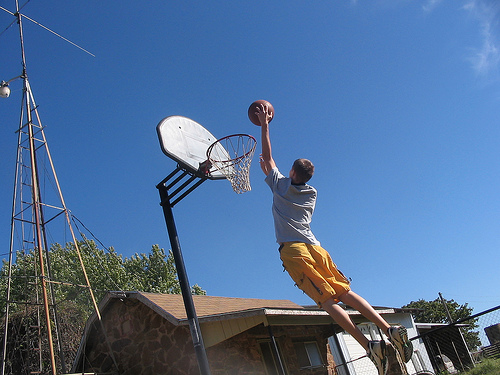Even if you don't have a garage or home gym stacked with equipment, you can still make great gains on your vertical if you are smart and strategic with your training. You can make use of plyometrics, medicine balls, and other forms of strength and speed training.
Learning how to improve your vertical jump at home consists of making use of your surroundings and getting creative with your training. You can do many of the same exercises that use fancy equipment for cheap or free.
It sounds obvious, but make sure to test your vertical maximum before starting any program. The only way to tell if a program is working is by testing before and after and comparing the results.

Photo By: Josh
Plyometric Jumps
Other than strength training, plyometrics may be the the best way to improve your vertical jump at home. According to a study by Goran Markovic, plyometric training can have a significant impact on vertical jump performance. Usually they are done using only your body as resistance, but if you are experienced you can use external resistance such as dumbbells.
Squat jumps are a great exercise for beginners, and they can be done with no resistance to start. After you've done these for some time, you'll want to add dumbbells as resistance. You can watch how to do them in the following video.
Depth jumps are great for developing power, although they shouldn't be used by beginners. You can see the technique in the video below.
Split lunge jumps are also awesome and incredibly challenging. From a lunged position, you jump up and land back in a lunged position, but this time with your other foot forward, and repeat. Your body is so low to the ground that you have to produce extra force to jump out of the position. Don't just focus on switching leg positions, you want to jump as high as you can. This is very taxing.
You want to be careful with plyometrics if you are new to them in order to reduce risk of injury. Don't jump into plyometrics if you are new to exercise or strength training. It is important to have a base level of lower-body strength before doing these explosive exercises.
Make sure to take a long rest period between sets of plyos and medicine ball exercises. You want to be fresh and recovered when performing explosive moves.
Medicine Ball Drills
Medicine balls are great, relatively inexpensive piece of equipment that allow you to do a variety of power development exercises. Many of these can be used in limited space outdoors, but some you will need a larger area. They can be used for throwing, which helps your upper-body, or jumping.
The overhead back med ball throw is great because it requires coordinating your entire body to create power. The exercise is demonstrated in the video below. One problem with this exercise is that it requires a lot of free space or netting. You can do the overhead back medicine ball throw for distance or height.
The medicine ball jumping lunge slam can help develop power in your upper and lower body. This exercise is demonstrated in the video below.
There are a variety of other medicine ball exercises. You can get creative with them and mix-and-match. Just remember to perform explosive reps, and not get caught up trying to see how many you can do. You want quality reps, not necessarily quantity.
Strength Training
Strength is absolutely essential to your leaping ability. Hopefully, you have a good strength base. If not, this is your priority 1. Jumping is all about developing force quickly. Your upside will be limited if you can only develop minimal force.
While you can do some bodyweight exercises to improve strength when you are getting started, you'll want legitimate weight room strength before doing serious jump training. Many recommend being able to squat 1.5-2 times your body weight before doing plyometrics.
The posterior chain is crucial for explosive movement. These areas consist primarily of your back, glutes, and hamstrings. These muscles can help absorb and transfer power. These muscles can be trained with compound barbell movements, such as:
- Squats
- Deadlifts
- Olympic Lift variations - snatch and clean
- Pull-ups and Chin-ups
Eccentric training can work well in your home, because sometimes a little bit of weight can go a long way. Eccentrics are the lowering portion of the exercise, and you can train this by lowering the weight slowly, followed by an explosive concentric, or raising, action.
The video below demonstrates walking lunges with a 4 second eccentric portion. If you do this for any reasonable distance, you will definitely feel the impact.
Below is video of an eccentric step up. In this exercise, you step up on one leg with explosive force. You then lower yourself back down slowly. Try a 4-count on the lowering portion. This can be done with no weight if you are new to the exercise. Eventually, you can add resistance in the form of dumbbells or something else. You can use a sturdy chair or bench that you have in your house.
You can target the hamstrings at home with Swiss ball hamstring curls. The exercise is demonstrated below. It doesn't look challenging, but you will be surprised at how your hamstrings feel when you are done with your set. When you are strong enough, you can perform this exercise with one leg at a time or use a larger Swiss ball. The nice thing about this exercise is that Swiss balls can be pretty inexpensive.
If you have a complete home or garage gym, then you'll obviously have many more options available to you, but I'm assuming you are looking for free or low-cost alternatives. If you do happen to have home gym equipment, you'll want to use compound free weight exercises, such as squats, deadlifts, and olympic lifts. You'll also want to provide extra, supplementary work for you back, hamstrings, and the rest of your posterior chain.
Speed Training

Photo By: Dean Hochman
Speed training and vertical jump training aren't exactly identical, but there is a significant crossover between the two. You can use short sprints, less than 50 meters, to work on explosive power.
Core Training
You probably hear all the time about how the core is important for pretty much anything you do, especially athletic movements. That is because it is true.
You'll want to strengthen your core in all directions for it to be functional to sports. While it may not matter for a max jumping test, it is still a good idea. In sports, you'll potentially be jumping from any and all angles, so you'll need to be able to apply powerful force in all those directions.
Planks, twists, side bends, and kettlebell swings are just a few examples of good exercises to improve your core strength. Using a variety of multi-directional exercises is what you should aim for.
Other Vertical Jump Factors
All other things being equal, the lighter athlete will jump higher. If you don't think this is true, try testing you vertical jump maximum. Then, put on a 20 pound weighted vest and test your max again. I'm pretty confident that you will see a significant decrease on your second attempt.
If you are looking to lose weight to jump higher, you want to be careful that you don't lose muscle mass and strength. If you lose weight, but it is mostly muscle, you may actually lose inches on your vertical jump despite being lighter.
Your vertical jump technique is also important. This is a great thing to practice at home, because you can work on it without any equipment. You can get a free report on how to improve your technique here. The important thing to know is that you may already be losing inches already if you aren't using good form.
If you want a finished, easy-to-follow program you can do at home, consider The Jump Manual by Jacob Hiller. You can find my review for it here.
Recap
Improving your vertical jump with home training may seem challenging, but a lot of the skills needed can be practiced with little or no equipment. With the right training, you'll add inches to your leaping ability quickly.

